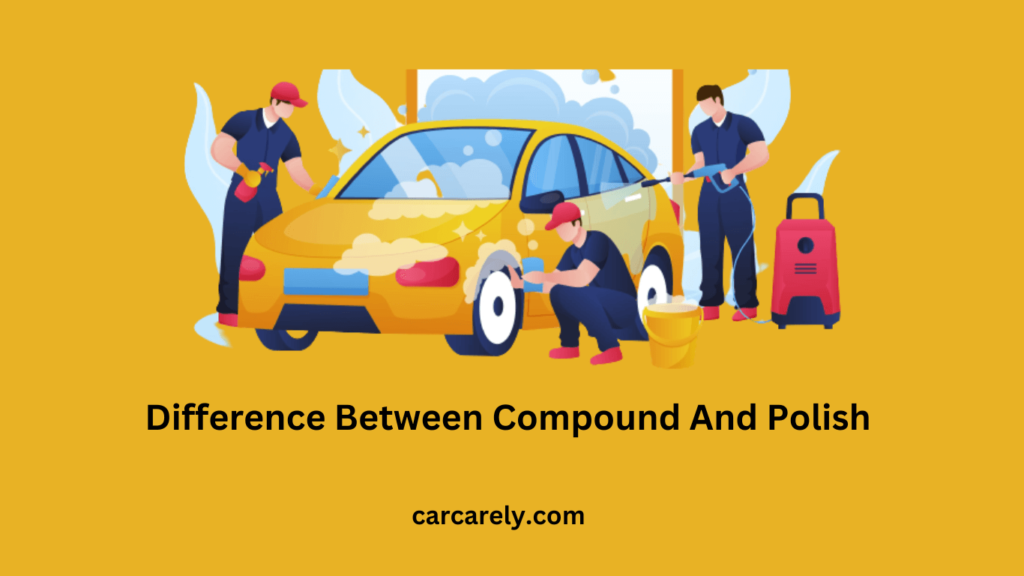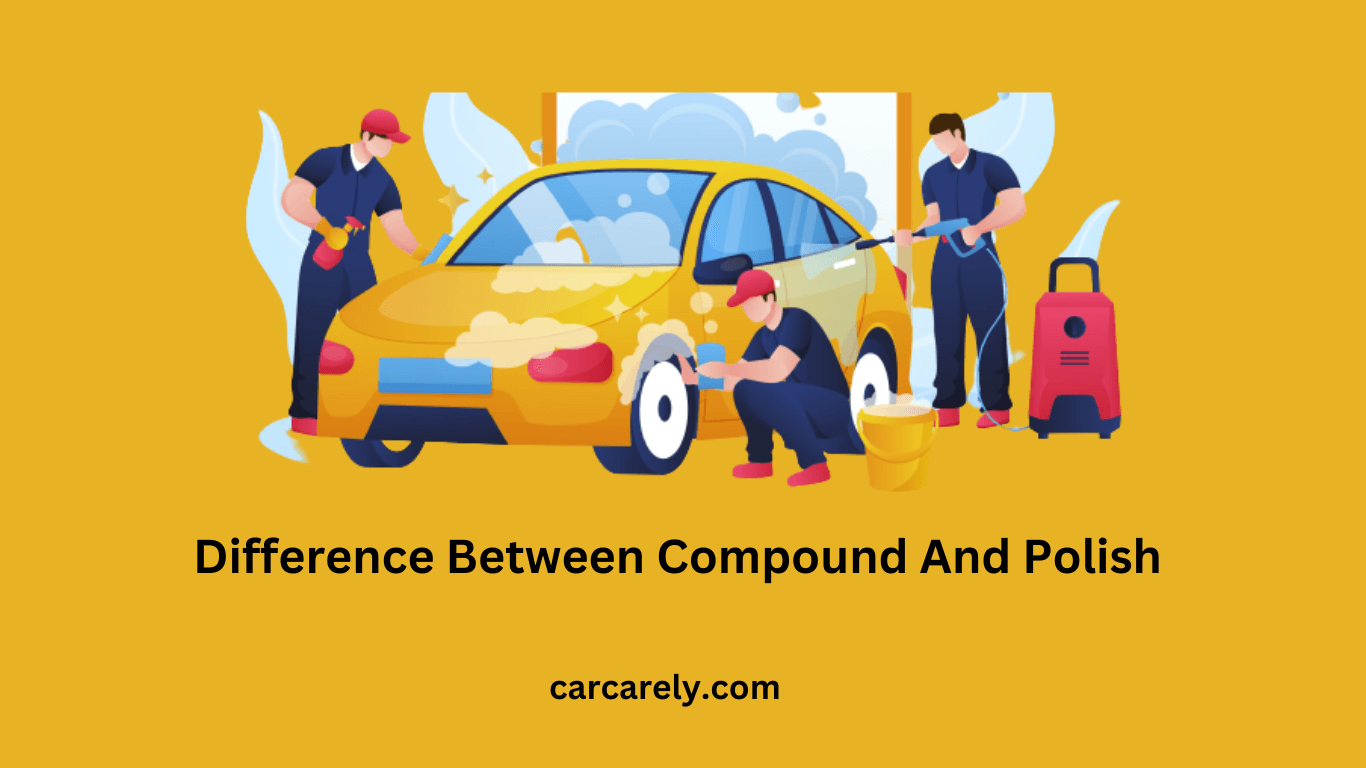Have you ever looked at your car’s paint and noticed swirls, scratches, or dullness? If so, you’re not alone… Many car enthusiasts struggle with keeping their paint looking new, but sadly, nothing seems to work out.
What if I told you the solution to this and other car problems could be a mix of compound or polish?
Though there isn’t such a vast difference between compound and polish, let me clarify.
The compound is used for significant scratches, whereas polish is used for minor swirls. That’s one way to define it.
However, for a better understanding, let us quickly move on to the article and then discuss their usage, ways, and benefits.
Difference Between Compound And Polish
A compound is a more abrasive product used for deep scratches, whereas polish is used to add lost gloss and shine.
Here is a detailed comparison for your better understanding.

Polish
Remember that polish adds a layer of protection to your car’s paint, which isn’t harmful.
This helps to prevent future damage from things like UV rays, bird droppings, and environmental contaminants. You can use polish to increase the paint shine and for simple day-to-day car maintenance.
Pros
- Polish is designed to enhance the shine and clarity of your car’s paint.
- Polish is generally easier to use than compound, which will significantly help if you are a DIY car owner.
Cons
- Polish may not be effective for more severe damage, such as deep scratches or heavy oxidation.
- To maintain the benefits of polish, you may need to apply it frequently, which can be time-consuming and expensive.
Compound
However, as for compound, it is used for more significant issues, including rough scratches, heavy oxidation, and much more.
It uses more aggressive abrasives to cut through the damaged paint layer, revealing a fresh layer of paint underneath.
Comparing it with polish, compound can be a bit harsher on your car’s paint than polish, so I won’t recommend using it for day-to-day tasks.
Pros
- It can be used for removing severe scratches.
- It can be a cost-effective method when compared with a proper paint restoration.
Cons
- Since the compound is highly abrasive, it might damage your car’s paint if not used properly.
- Unprofessional usage can also cause the compound to leave swirl marks, which can be difficult to remove without a polish or other specialized product.
Also Read: Can You Use Tire Shine On Plastic Trim?
Compound VS Polish- Applying Methods
Once we have understood the basics of compound and polish, it’s deep time our brain is pondering about how to section.
To cut it short, Polish is easier to apply if we compare it with a compound. Here is a professional step-by-step guide for applying compound and polish.
How To Apply Compound
- It is recommended to clean your car properly before applying the compound.
- Apply a small amount of compound to your foam or microfiber pad.
- Work in small sections. Start with a section that’s about 2-3 feet square.
- Apply the compound to the section using light pressure, working in a back-and-forth or circular motion. Don’t just go into fierce mode and start pushing the pad (this can damage the car paint)
- Now that you’ve applied the compound and wiped off the excess. Inspect the section to see if the imperfection has been removed. If necessary, you can apply more compound and repeat the process until the imperfection is gone.
- Once done, move on to the other parts of the car until you have a clean car ready to be auctioned for Fast and Furious X.
How To Apply Polish
- Start by washing the car. Dry it with a microfiber cloth and ensure the whole surface, especially the scratched part, is dry.
- You can apply any of the car polishes depending on the severity of the case.
- Circularly rub the car polish with a buffing pad or microfiber towel.
- Now let the polish dry and…
- Woah! I see quite a shiny car now. Are you sure it’s yours?
Also Read: How Many Times Can I Polish My Car
What Are The Different Types Of Compounds?
Increment and Decrement of letters, I guess???
Just kidding…
Many types of compounds are used depending on the type of purpose. Usually, there are two famous types of compounds used in automobiles.
I see… Curious about their names?
Well, there is the rubbing compound and the polish compound.
Rubbing Compounds
The rubbing compound is quite the everyday compound we hear of from every car mechanic or online automobile expert.
It is designed to remove scratches, oxidation, and other imperfections from automotive and marine surfaces.
Polish Compounds
Polishing compounds are used to create a smooth, glossy finish on surfaces.
You can purchase a polish compound and include it in your daily car cleaning or maintenance kit, as it has no severe side effects.
Wax Compounds
Wax compounds form a protective layer that helps prevent damage and maintain the surface’s shine.
Quite similar to Polish compounds.
They protect and preserve painted surfaces from UV rays and other environmental factors.
Compound VS Polish- Which One To Choose
This might sound unclear, but the answer depends on several factors.
If you have an old or scratched car, the compound is just the option you were looking for to boost its class and make you look like Dom Toretto.
However, for new edition cars which haven’t gone through a lot. Polish is the option to jump for.
It might not fix huge problems, but little swirls and lost looks are nothing complicated for the polish to erase.
Before moving on to some final tips, here’s a bro tip.
Always carry both polish and compound in your car maintenance kit. While many say you can only use it once at a time, I’m afraid I have to disagree.
If you are purchasing a black 1968 fastback Mustang, there will be the need for extra shine and some significant scratches as well (only if you haven’t restored it already)
Final Words
Now that you have understood the difference between these, I expect you know a lot about detailing the cars’ exteriors.
However, it is essential to remember some points while applying compound and polish.
While many people always read the pressure prohibition note on most compound products, some still do it and ruin the clear coat from the base.
I recommend taking deep breaths before starting the coat and holding the microfiber towel with light hands.
Though this may sound lame, it works…
Don’t believe me? Try it for yourself.
FAQ
Can I use a compound or polish it by hand?
While it’s possible to use a compound or polish by hand, using a machine polisher is generally more effective. The machine helps to evenly distribute the product and apply consistent pressure, which can produce better results. Want to know the best part? The machines aren’t costly as well.
How often should I use a compound or polish?
The frequency of use will depend on the condition of the surface and the type of product you are using. Generally, compounds are used less frequently than polishes; only use them when necessary to remove imperfections. Polishes can be used more often to maintain the shine of your surfaces.
Can I use car polish on other surfaces?
Though it’s possible, I won’t advise you to do it. Car polishes are designed for automotive surfaces, but some may be suitable for other surfaces, such as fiberglass, plastic, or chrome. It is better to check the product label and do a small test spot before applying it to the entire surface.
Read More:
